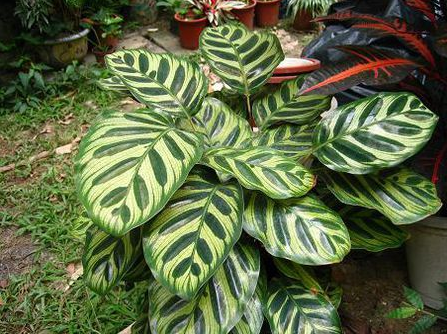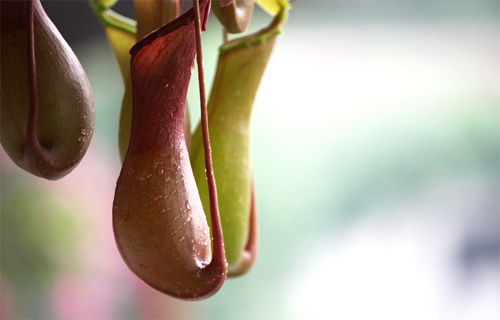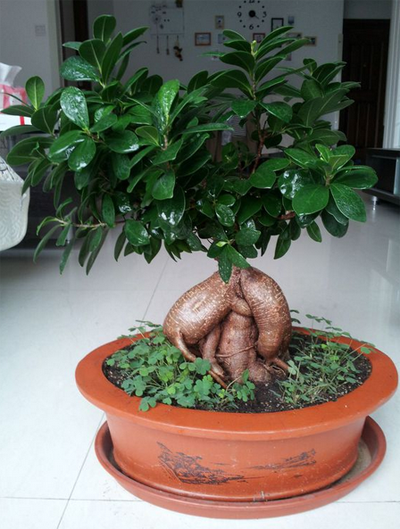How do you handle the yellow and curly leaves of peacock arrowroot?
What does a peacock bamboo taro look like? Why is there such a gentle name? Because the leaves of peacock taro grow like peacock feathers, they are very good-looking. What is the breeding method of peacock taro? What are the precautions? What if the leaves turn yellow and curl?

1. Lighting
It does not like exposure to the sun, so the leaves will burn, leaving ugly markings, of course, usually have bright light on the line, resistant to semi-shade, pay attention to ventilation, peacocks and taro do not like the muggy environment.
It is recommended to keep the balcony in the north, so ask me what the balcony is? Take the peacock bamboo taro home.
2. Watering and humidity
As an excellent air purification plant, peacock taro does not have too many requirements for the environment, usually the basin soil is slightly moist, not too dry, of course, there can be no stagnant water, I am not responsible for rotting roots.
Watering regularly, there is a lot of spraying in the weather (sunny day), do not let the basin soil dry for too long, many friends come back from a business trip and travel to see that the peacock bamboo taro can not get up on the ground, the soil is too dry, no, away from home for a long time, support friends to take care of or make a simple automatic watering tool!
3. Fertilization
In the growing period (except hot summer and winter) about once a month to apply fertilizer, of course, to grasp the principle of frequent application of thin fertilizer, fertilizer choice of indoor green leaf fertilizer, I will not introduce the specific brand, I also have. Note: little or no fertilization in winter and summer, liquid fertilizer should not be left on the leaves.
4. Temperature
As a warm and humid plant, of course, it is not cold-resistant, in winter, the temperature above 10 degrees is safe, above 15 degrees is the best, the growth temperature is about 15-25 degrees, high temperature must be ventilated, muggy conditions spray more water to cool down!
5. Selection of basin soil
Peacock taro likes slightly acidic humus that is well drained, fertile and loose (looks black, feels loose and easily watered). A small amount of mature base fertilizer, rotten leaf soil, peat soil and river sand can be added to the cultivated soil to make the basin soil more in line with its growth needs.
Peacock bamboo taro disease and insect protection:
Peacock bamboo taro is rarely sick when the air is dry, poorly ventilated, stuffy and overwatered. If it is root rot, it is necessary to control water ventilation, usually due to frequent watering, stagnant water in the basin or loose soil.
Usually, it is necessary to remove the diseased leaves in time, and the dead leaves should not be left in the basin soil to keep the environment clean!
Dry, hot and easy to grow shell insects, whitefly, etc., can be sprayed with 1000 times of 25% imidophos emulsion or 40% omethoate 1500 times.
The propagation mode of peacock bamboo taro:
The simple implementation is to split the plants, separate the lateral buds, plant them in the slightly moist sandy soil, maintain them in a semi-shady ventilation place, and do not pour too much water in the early stage, so that it is not easy to take root.
Note: generally carried out in the spring and autumn, it is best to combine the basin change, the temperature is about 20 degrees for the highest survival rate! Of course, you can also cut the luxuriant rhizome into ramets, but it's too cruel.
What about the curly leaves and yellow leaves of peacock bamboo taro?
Generally speaking, it is caused by too little watering, so it should be watered regularly and watered when the growth period is dry to prevent frostbite in winter.
Of course, to prevent frostbite is also very important, move to a warm place, of course, the weather is getting warmer now!
When the summer temperature is higher than 35 ℃, it will not be long and the leaves will turn yellow. The leaves below 10 ℃ are easy to curl in winter, and less than 5 ℃ are susceptible to cold injury, and will hang up in severe cases. Pay attention to cold protection and heat preservation in winter, and room temperature should be kept above 13 ℃.
The breeding method of peacock bamboo taro and the problems in the breeding process are introduced here, so quickly add a little green to your home.
How to curl the leaves of peacock taro? do peacock taro blossom?
Peacock taro is an ideal indoor greening plant, many people like to raise peacock taro at home, used for indoor decoration. But in the process of breeding peacocks bamboo taro leaves curl how to do? Do peacocks blossom? Let's take a look at the answer today.
What if the peacock bamboo taro leaves curl?
First, the reason: the ambient temperature and humidity are uncomfortable.
Symptoms: Peacock bamboo taro leaves atrophy and curl, and no longer stretch freely. If no measures are taken, the leaves and roots will rot over time, and even wither and die.
Solution:
1. Strengthen daily water and fertilizer management
2. Spray 3 times a day to the plant and its surrounding environment, except for the overcast and rainy weather.
3, bagging if the leaf atrophy is particularly serious, you can cover all the plants with plastic bags and poke some small holes at the mouth of the basin slightly above 5mm, which can not only maintain a certain humidity, but also be properly ventilated to facilitate recovery.
Second, the reason: too little watering, too low humidity.
Symptoms: Peacock bamboo taro leaves curled and accompanied by partial death, lower leaves withered and yellow.
Solution: peacock taro is native to the tropical rain forest of South America, which requires a very humid special environment. In addition to keeping the basin soil moist and not watering the basin soil after drying, there is no phenomenon of stagnant water and rotten roots. High air humidity should also be maintained in the surrounding environment. For this reason, it should be shelved in a semi-shady place in summer, spray water to the leaves 2 to 3 times a day, and sprinkle water to the surrounding ground, so as to humidify and cool down and promote the robust growth of the plant.
In addition, avoid basin soil stagnant water, can not apply raw fertilizer, thick fertilizer, big fertilizer, otherwise cause nutrient fibrous root rot, will also lead to its leaves curling and yellowing.
Do peacocks blossom?
Peacock taro can blossom, but the temperature must be reached. Peacock taro is a foliage plant, but its flowering is not good-looking. It is not easy to blossom in the north due to the influence of climate and temperature, but it can blossom year after year in the south. Some will cut off the buds in order to avoid nutrition consumption.
For more information, what to do about the leaf curl of peacock bamboo taro, adjust the temperature to increase humidity / watering to the right amount
For peacock taro, friends who have seen it should be impressed. Its leaves are not only evergreen all the year round, but also have a peacock feather pattern on it, which is really very strange. Because of the ornamental value of peacock bamboo taro, many people will keep it at home, but the leaves of peacock bamboo taro leaves curl, how is this going on? Today the editor will tell you the answer.
1. Peacock bamboo taro leaves curl, find the reason
Peacock taro is a tropical plant, it likes high temperature, high humidity environment, in indoor breeding, because the environment is not up to standard, the peacock taro will often appear curly phenomenon, the leaves can not stretch freely, and the lower leaves of the plant will appear withered and yellow. What about the peacock bamboo taro leaf curl? In this regard, the editor summed up four reasons, and attached solutions, let's move on.
2. the causes of the curl of peacock bamboo taro leaves and its solutions.
1. Improper temperature and humidity
According to the editor, generally speaking, the leaves of peacock bamboo taro curl because of inappropriate temperature and humidity.
① temperature is too low
Peacock taro is a tropical plant, it likes the high temperature growth environment, in indoor breeding, if the temperature is too low, it will make it curl.
The solution: simply move the peacock taro to a place with a high temperature (above 16 ℃). However, it should be noted that do not move to a place where the temperature is too high. After careful maintenance for a period of time, the leaves will return to health.
② is not humid enough.
In addition to the high temperature, peacock bamboo taro also likes the high humid environment, in peacetime we should ensure that the basin soil and air should be kept at a high humidity. Once the humidity is not enough, the peacock bamboo taro leaves will curl.
Solution: sprinkle water around the peacock taro to increase air humidity; in addition, we should often spray water on the leaves to cool and moisturize, with a humidity of 70% and 80% at best.
2. Improper watering
In addition to the solution and improper humidity, if the watering method is not correct, too much watering or not watered for a long time, there will also be symptoms of peacock bamboo taro leaf curling.
Too little watering for ①
Peacock bamboo taro likes a humid environment and usually needs more watering to keep the basin soil moist. Once the water is too little, the lack of water can not meet the growth needs of peacock taro, and its leaves will also appear curly symptoms.
Solution: replenish the peacock taro with water, but don't pour too much water at once, just keep the basin soil moist.
② watered too much
In addition, too much watering leads to stagnant water in the basin, which is also the reason for the curl of peacock bamboo taro leaves. Peacock taro likes to be wet, but if there is water in the basin, it will cause its rotten roots, curly leaves and yellowing.
Solution: move the peacock taro to a ventilated astigmatism and let the water evaporate quickly; in serious cases, replace it with fresh cultivated soil, and then replant it.
- Prev

Nepenthes plant pests scale insects leaf spot blight
Nepenthes this fierce can also have pests, not Nepenthes is specialized in eating insects? Can also be eaten by insects, scale insects are really Nepenthes nemesis, Nepenthes what pests do they have? How should we deal with it? blight, blight of newly purchased pitcher leaves and cages, usually caused by maladjustment
- Next

Culture methods and matters needing attention of ginseng banyan how to lose leaves
Some people's ginseng banyan is very luxuriant, very good-looking, the bottom of ginseng banyan is like a person, so there is the saying of ginseng banyan, what are the culture methods and precautions of ginseng banyan? What if the leaves fall off in the process of breeding?
Related
- Fuxing push coffee new agricultural production and marketing class: lack of small-scale processing plants
- Jujube rice field leisure farm deep ploughing Yilan for five years to create a space for organic food and play
- Nongyu Farm-A trial of organic papaya for brave women with advanced technology
- Four points for attention in the prevention and control of diseases and insect pests of edible fungi
- How to add nutrient solution to Edible Fungi
- Is there any good way to control edible fungus mites?
- Open Inoculation Technology of Edible Fungi
- Is there any clever way to use fertilizer for edible fungus in winter?
- What agents are used to kill the pathogens of edible fungi in the mushroom shed?
- Rapid drying of Edible Fungi

